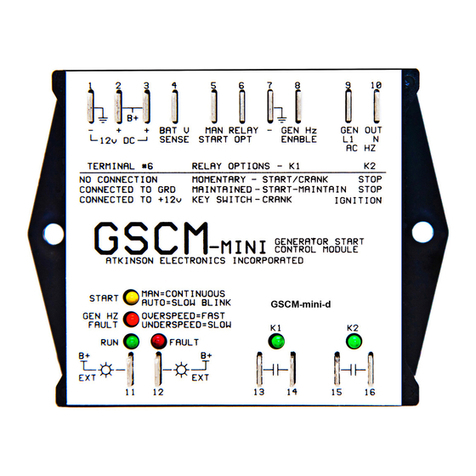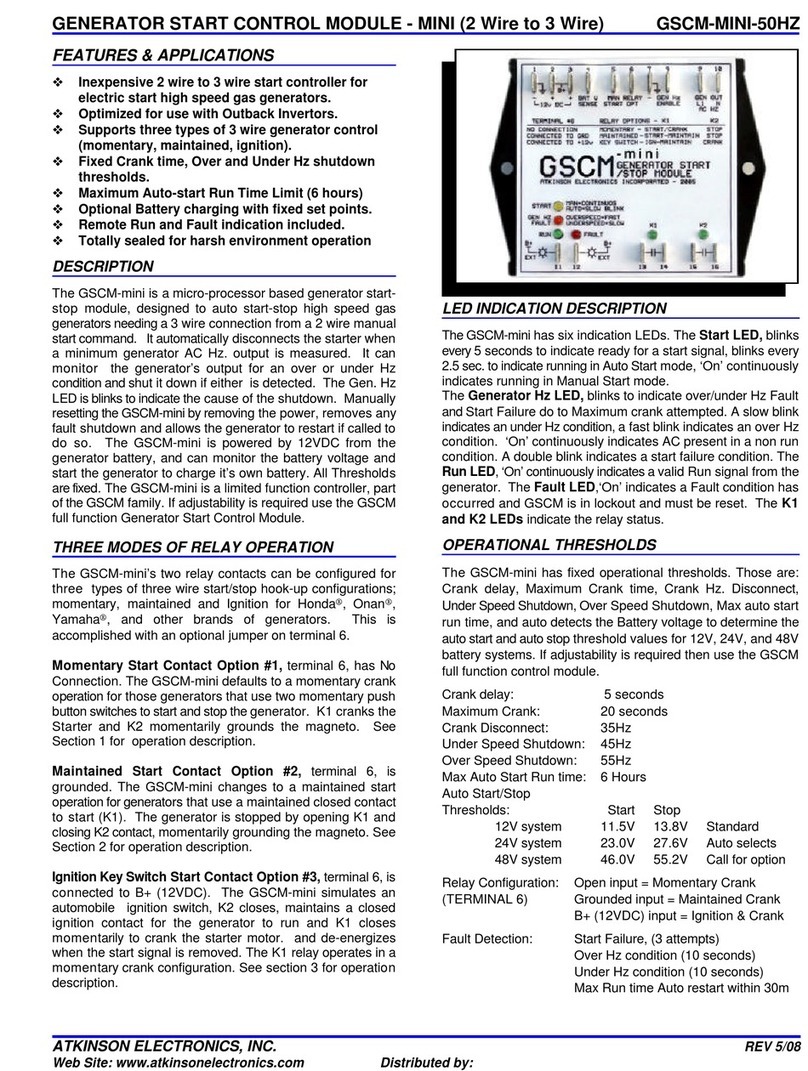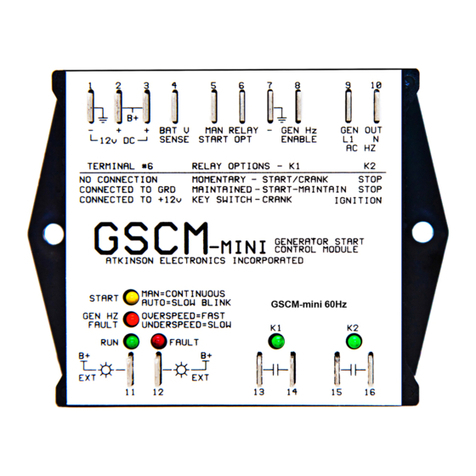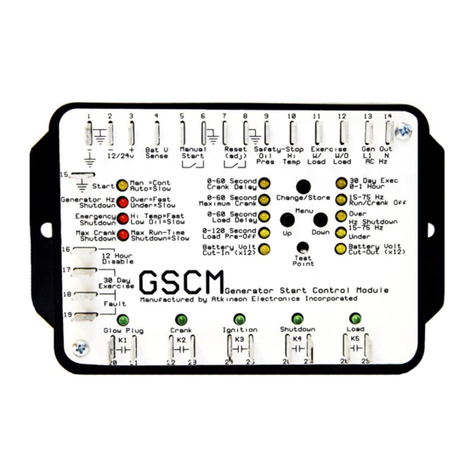
www.atkinsonelectronics.com
Circuit Board Division
800.261.3602 6 Revised 02/21
GSCM-mini-P Option #2 Cummins/Onan, Westinghouse push to start/stop
The GSCM-mini-P’s configuration terminal # 6 is connected to +12VDC (terminal # 3), this configures the GSCM-mini-P
for a 1 second start/stop pulse on the K1 relay contact and a maintained power/run on the K2 contact. When the
GSCM-mini-P is powered by connecting B+ (12.0 VDC) to terminal 2, the Start LED turns on for 5 seconds while the
GSCM-mini initializes with option #2 configuration then begins blinking the start LED once every 5 seconds. The GSCM-
mini’s starting sequence is as follows.
1. The start LED blinks once every 5 seconds to indicate that the GSCM-mini is in a “ready” mode. When a manual
start signal is received, the start LED lights continuously. After a 2 second delay, K2 relay energizes closing its
normally open contact to power the generator’s ECU, then after another 2 second delay, it provides a 1 second
start pulse by energizing the K1 relay contact for 1 second. The generator’s ECU then makes three attempts to
start the generator.
2. If the generator fails to start during the three starting attempts and rest periods, approximately 50 seconds, the
generator will go into a failed to start fault requiring the generators ECU to be reset by powering down the
generator. The GSCM-mini-P starts a 1 minute timer when it provides the start pulse and looks for a valid run
feedback signal.
3. The run feedback signal can be either: a 12vdc status pilot lamp signal provide by the generator that is connected
to the GSCM-mini-P’s terminal #8, or by the generator producing its 120VAC output which would be connected to
the GSCM-mini-P’s GenHz input (terminal #9 and 10).
4. When the generator starts and the GSCM-mini-P receives the feedback signal it drops in to the run mode turning
on the green run LED.
5. If the generator fails to start after 3 three starting attempts, the GSCM-mini-P’s 1 minute start timer expires and
the GSCM-mini runs thru its re-start routine, de-energizing the K2 relay powering down the generator, which
clears it failed to start fault, then waits 15 seconds and repeats the starting routine.
6. If the generator fails to start after the second round of three attempts the GSCM-mini-P turns on its red fault LED
and the GSCM-mini enters the Maximum crank lockout condition and the Generator Hz LED does a double blink.
This lockout condition remains until the GSCM-mini is reset by removing power from terminal 2, waiting 5 seconds
and reconnecting power. This clears the lockout condition, and returns to ready mode.
7. If the generator starts but shuts down after a few seconds due to a fuel problem, etc. The GSCM-mini goes thru
its shutdown routine then re-enters ready mode after a 60 second delay. During this delay the start LED will blink
rapidly. The GSCM-mini will then try to start the generator again in manual mode or after a 5 minute delay period
in auto-start mode.
8. When a run condition is detected, the GSCM-mini turns on the run LED and open collector transistor output
(remote run lamp) and after a 60 second generator stabilization period it monitors the run feedback signal.
9. If the generator starts but shuts down after the 60 seconds stabilization period, due to a fuel problem, low oil
pressure, broken AC Hz or 12V run pilot light status wire, the GSCM-mini turns off the run LED and turns off K2
relay, and turns on the fault LED blinks the orange GenHz LED five times every two seconds. The GSCM-mini enters
a fault shutdown lockout condition and must be powered down to reset the fault lockout.
10. If no faults occur, the generator continues running until one of the following occurs: The manual start signal is no
longer received, the auto battery charge voltage or max run time has been reached while running in auto charge
mode, an over or under Hz condition occurs if generator Hz shutdown is enabled or the generator runs out of gas.
11. Shutdown routine, K1 provide a 1 second stop pulse, then 15 second later K2 relay de-energizes, powering down
the generator.
12. The generator remains off until another start signal is received.
































